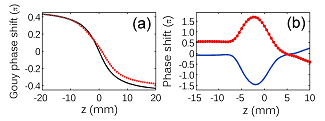Waveform-controlled THz radiation is of great importance due to its potential application in THz imaging and coherent control of molecular dynamics. Recently, Bai Ya et. al. in Prof. Li Ruxin and Prof. Xu Zhizhan’s group at Shanghai Institute of Optics and Fine Mechanics, Chinese Academy of Sciences(SIOM, CAS), have reported a novel scheme to generate waveform-controlled THz radiation from plasma filaments in air produced by carrier-envelope-phase (CEP) stabilized few-cycle laser puluses[Phys. Rev. Lett. 108, 255004 (2012).].
They utilize a home-built few-cycle IR laser system, which composes of a Ti:sapphire pumped optical parametric amplifier (OPA) system and a hollow fiber compressor [Opt. Express 19, 6783 (2011).], to carry out the experiments. The CEP-stabilized 10fs-long (~1.7 optical cycles) laser pulses at 1.8mm was focused by concave mirror and collapsed into air filament. They found that the generated THz waveforms can be controlled by varying the filament length and the CEP of driving laser pulses.
In order to investigate the evolution of driving laser pulse and THz radiation in the filament, a sharp stainless steel blade was inserted into the plasma column to stop the filament, which can be moved by a motor stage along the laser propagation direction, so that the detection of THz radiation from the upstream unperturbed filament is lest influenced, and then the integrated THz signals from filaments of different lengths are measured.
In model calculation, they consider the THz emission originated from the transient photocurrent driven by the propagating intense few-cycle laser fields in the plasma. Since the Rayleigh length is no longer valid in filament, they initialized the idea the modified Gouy phase shift that is characterized by effective length zeff. The modified Gouy phase shift due to the extension of filament confirms the previous theoretical prediction that the Gouy phase shift stems from transverse spatial confinement of a finite beam. In simulation, the THz amplitude as a function of filament length is found in consistence with the measured results.
Understanding the laser phase effect and propagation effects on the THz radiation from the few-cycle laser pulse produced filament is crucial for the THz generation based CEP metrology and the generation of intense and waveform-controlled THz radiation.
This work is supported by Chinese Academy of Sciences, Chinese Ministry of Science and Technology, NNSF of China (Grant Nos. 60921004, 10734080, 10523003, 60978012, and 11134010), 973 Program of China (2011CB808103), and Shanghai Commission of Science and Technology (No. 08PJ14102).
 |
| FIG. 1 (a) THz temporal waveforms measured from the filaments of different length 3mm (red solid line) and 10 mm (black dashed line), respectively; (b) THz waveforms measured by moving the block continuously along the filament; (c) The measured THz amplitudes (green solid squares) taken from Fig. 1(b) at the delay time of 1ps, the calculated results (black solid line), and the retrieved THz signal amplitude (red solid circles) as a function of the position in the filament.(Image by SIOM) |
 |
| FIG. 2 (a) The modified Gouy phase shift (red dashed line) and the Gouy phase shift (black solid line) of linear focus condition; (b) The pulse front shift (blue solid line) and the CEP shift (red dotted solid line) of the laser field in air plasma.(Image by SIOM) |